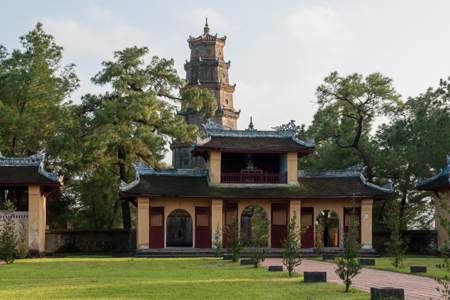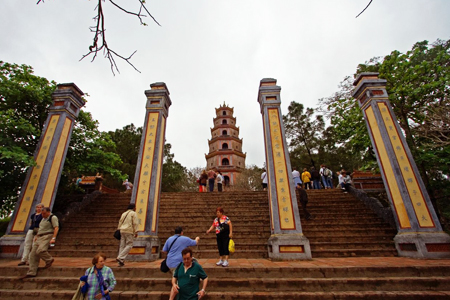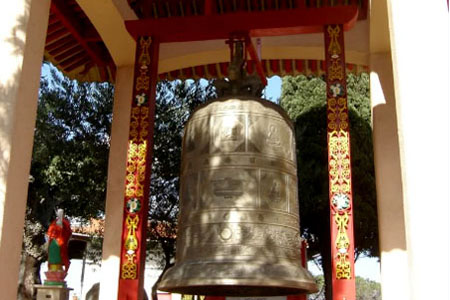If One Pillar Pagoda has long been the pride of Hanoians, Thien Mu Pagoda is also the symbol of Hue and has become one of the most sacred sites in the Central Vietnam. Sitting on Ha Khe overlooking the Perfume River, in Huong Long village, this beautiful pagoda is not only a symbol of Hue as the Citadel, but also the most fascinating and ancient Pagoda in poetic Hue.

The name of this pagoda is derived from a local legend. Legend has it that long time ago, local residents saw an old lady in red appearing on the top of the hill where the pagoda stands today. She told that one day, the Lord would pass by and build Buddhist pagoda for the country's prosperity. Exotically, the Lord Nguyen Hoang actually went pass the hill. After he had heard about the legend, he had the Pagoda constructed and named it Thien Mu. Due to this mysterious story, the pagoda attracts a number of both domestic and international tourisms especially pilgrims.
The pagoda was originally built in 1601, under the reign of Nguyen Dynasty. Initially, the construction form of the pagoda is very simple, but as time went by, several Kings of Nguy Dynasty such as Gia Long, Minh Mang had it expanded and renovated with more intricate features. Despite experiencing many renovations, natural damages; witnessing many ups and downs of the country, today the pagoda still exists and remains the unofficial symbol of the ancient city Hue.

The first thing that seizes the attention of tourists is the 21m - high octagonal tower, Phuoc Duyen tower. It was erected under the reign of Emperor Thieu Tri in 1844. Seven storey of the tower is dedicated to a manushi-buddha (a Buddha that appeared in human form). Its striking feature has been the subject of folk rhymes and cadao about Hue, such is its iconic status and association with the city.
To the left of the tower is a pavilion sheltering an enormous bell called Dai Hong Chung. Its name is actually the name of a poem which was carved on the bell. it Lord Nguyen Phuc Chu got it cast in 1710. Due to its great size, 2.5m high and 3,285 kg weigh, the bell is considered a remarkable achievement of 18th century bronze casting.
To the right of the tower is a pavillion containing a stela dated from 1715. It is set on the back of a massive marble turtle, a symbol of longevity, and is 2.58 m high.

Fully enjoy a prestigious sightseeing tour, take in the scenery landscape and marvel at the typical traditional architecture of Hue pagodas. Due to the prime location, tourists could soak up a mind-boggling view of both the flow and the surrounding areas from high position upward a charming curve of Perfume River. Owning to pine trees, bonsai and delicate manmade pond bounding the pagoda, this religious site is a place where you could get a peaceful feeling which is hard to find anywhere else.



